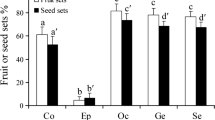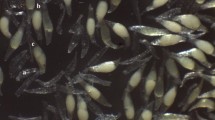Abstract
Sexual and asexual reproduction may occur simultaneously in some plant species. Under certain environmental conditions asexual reproduction is predominant, which generates ecological consequences on sexual fecundity. In this context, we studied the reproductive ecology of the creeping clonal cactus Echinopsis thelegona in La Bodega (Salta, Argentina), where low fruit and seed production was preliminarily observed. Specifically, we studied the flower availability, fruit and seed production, reproductive system, floral visitors and effects of neighbor ramets on reproductive success. The number of available flowers per day was low, and fruit production was low or null as well. Echinopsis thelegona is self-incompatible. Although its flowers have sphingophilous traits, we did not find evidence of moths visiting them. Only native and exotic bees visited the flowers of this species, though with a low number of visits. Therefore, nocturnal visitors were not registered as pollinators of E. thelegona, perhaps because of their low local abundances. On the other hand, bees behaved as inefficient pollinators of E. thelegona due to their foraging behavior, which moves pollen within individuals. A pollen-addition experiment revealed that there is no fruit production at short distances among ramets. Therefore, the combination of self-incompatibility, low flower production and low local abundance of pollinators could account for the low fruit production observed in this species. This finding suggests that populations of E. thelegona persist by clonality and that they tend toward the loss of sexuality.


Similar content being viewed by others
References
Alonso-Pedano M, Ortega-Baes P (2012) Generalized and complementary pollination system in the Andean cactus Echinopsis schickendantzii. Plant Syst Evol. doi:10.1007/s00606-012-0668-7
Abrahamson WG (1980) Demography and vegetative reproduction. In: Solbrig OT (ed) Demography and evolution in plant populations. University of California Press, Berkely, pp 89–106
Beatty GE, McEvoy PM, Sweeney O, Provan J (2008) Range-edge effects promote clonal growth in peripheral populations of the one-sided wintergreen Orthilia secunda. Diversity Distrib. 14:546–555
Bianchi AR, Yañez CE (1992) Las precipitaciones en el noroeste argentino. INTA, Salta
Bianchi AR (1996) Temperaturas medias estimadas para la región noroeste de Argentina. INTA, Salta
Billingham MR, Reusch TBH, Alberto F, Serrão EA (2003) Is asexual reproduction more important at geographical limits? A genetic study of the sea grass Zostera marina in the Ria Formosa. Portugal Mar Ecol Prog Ser 265:77–83
Carrillo-Angeles I, Mandujano MC, Golubov J (2011) Influences of the genetic neighborhood on ramet reproductive success in a clonal desert cactus. Popul Ecol 53:449–458
Charpentier A (2002) Consequences of clonal growth for plant mating. Evol Ecol 15:521–530
Clark-Tapia R, Alfonso-Corrado C, Mandujano MC, Molina-Freaner F (2006) Reproductive consequences of clonal growth in Stenocereus eruca, a rare clonal cactus of the Sonoran Desert. Evol Ecol 20:131–142
Clark-Tapia R, Molina-Freaner F (2004) Reproductive ecology of the rare clonal cactus Stenocereus eruca in the Sonoran Desert. Plant Syst Evol 247:155–164
Dorken ME, Eckert CG (2001) Severely reduced sexual reproduction in northern populations of a clonal plant, Decodon verticillatus (Lythraceae). J Ecol 89:339–350
Eckert CG (2002) The loss of sex in clonal plants. Evol Ecol 15:501–520
Eriksson O (1993) Dynamics of genets in clonal plants. Trends Ecol Evol 8:313–316
Fleming TH, Tuttle MD, Horner MA (1996) Pollination biology and the relative importance of nocturnal and diurnal pollinators in three species of Sonoran Desert columnar cacti. Southwest Nat 41:257–269
Godínez-Alvarez H, Valverde T, Ortega-Baes P (2003) Demographic trends in the Cactaceae. Bot Rev 69:173–203
Gross CL, Caddy HAR (2006) Are differences in breeding mechanisms and fertility among population contributing to rarity in Grevillea rhizomatosa (Proteaceae)? Am J Bot 93:1791–1799
Honnay O, Bossuyt B (2005) Prolonged clonal growth: escape route or route to extinction? Oikos 108:427–432
Honnay O, Jacquemyn H (2008) A meta-analysis of the relation between mating system, growth form and genotypic diversity in clonal plant species. Evol Ecol 22:299–312
Hunt D (2006) The new cactus lexicon. DH Books, England
INFOSTAT (2009) InfoStat versión 2007. Grupo InfoStat. FCA, Universidad Nacional de Córdoba, Argentina
Mandujano MC, Montaña C, Méndez I, Golubov J (1998) The relative contributions of sexual reproduction and clonal propagation in Opuntia rastrera from two habitats in the Chihuahuan Desert. J Ecol 86:911–921
Mandujano MC, Carrillo-Angeles I, Martínez-Peralta C, Golubov J (2010) Reproductive biology of Cactaceae. In: Ramawat KJ (ed) Desert plants. Springer, Berlin, pp 197–230
Olson DM, Dinerstein E (2002) The global 200: priority ecoregions for global conservation. Ann Missouri Bot Gard 89:199–224
Ortega-Baes P, Godínez-Alvarez H (2006) Global diversisty and conservation priorities in the Cactaceae. Biodiversity Conserv 15:817–827
Ortega-Baes P, Aparicio M, Galíndez G (2010a) Vivipary in the cactus family: an evaluation of 25 species from northwestern Argentina. J Arid Environ 74:1359–1361
Ortega-Baes P, Aparicio-González M, Galíndez G, del Fueyo P, Sühring S, Rojas-Aréchiga M (2010b) Are cactus growth forms related to germination responses to light? A test using Echinopsis species. Acta Oecol 36:339–342
Ortega-Baes P, Saravia M, Sühring S, Godínez-Alvarez H, Zamar M (2011) Reproductive biology of Echinopsis terscheckii (Cactaceae): the role of nocturnal and diurnal pollinators. Plant Biol 13:33–40
Ortega-Baes P, Sühring S, Sajama J, Sotola E, Alonso-Pedano M, Bravo S, Godínez-Alvarez H (2010c) Diversity and conservation in the cactus family. In: Ramawat KJ (ed) Desert plants. Springer, Berlin, pp 157–173
Petit S, Pors L (1996) Survey of columnar cacti and carrying capacity for nectar-feeding bats on Curaçao. Conserv Biol 10:769–775
Pimienta-Barrios E, del Castillo RF (2002) Reproductive biology. In: Nobel PS (ed) Cacti: biology and uses. University of California Press, Los Angeles, pp 163–183
Sahley CT (1996) Bat and hummingbird pollination of an autotetraploid columnar cactus, Weberbauerocereus weberbaueri (Cactaceae). Am J Bot 83:1329–1336
Vallejo-Marín M, Dorken ME, Barrett SCH (2010) The ecological and evolutionary consequences of clonality for plant mating. Annu Rev Ecol Evol Syst 41:193–213
Walter H (2010) Floral biology of Echinopsis chiloensis ssp. chiloensis (Cactaceae): evidence for a mixed pollination syndrome. Flora 205:757–763
Acknowledgments
The authors thank the handling editor, Marlies Sazima, and anonymous reviewers for their insightful comments that have improved this manuscript. The authors also thank Martín Pekarek for the permission to carry out research at La Bodega ranch. We are grateful to Silvia Sühring for reviewing the manuscript. Nora Frizza assisted with the English version of this manuscript. The research was funded by CIUNSalta (Grant Nos. 1306 and 1666) and FONCYT (Grant Nos. 36822 and 1492).
Author information
Authors and Affiliations
Corresponding author
Rights and permissions
About this article
Cite this article
Ortega-Baes, P., Gorostiague, P. Extremely reduced sexual reproduction in the clonal cactus Echinopsis thelegona . Plant Syst Evol 299, 785–791 (2013). https://doi.org/10.1007/s00606-013-0761-6
Received:
Accepted:
Published:
Issue Date:
DOI: https://doi.org/10.1007/s00606-013-0761-6




